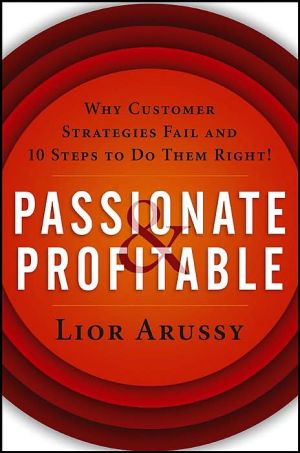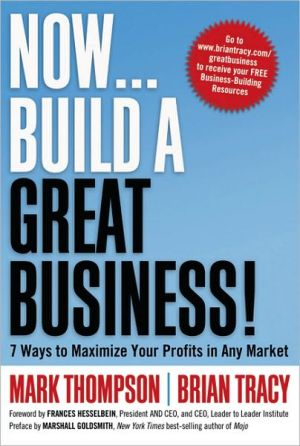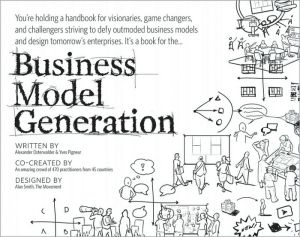Passionate and Profitable: Why Customer Strategies Fail and Ten Steps to Do Them Right!
"Lior Arussy's new book is another great addition to his work on the theme of improving the customer experience to build lasting and profitable customer relationships. Recommended to both those working on corporate customer strategy and line managers. Strong practical advice from an industry visionary."\ —Michael Maoz Vice President and Research Fellow, Gartner Research\ "This book isn't filled with easy shortcuts and feel-good platitudes. When you're ready to walk the walk, Lior's book is a...
Search in google:
Why, despite spending billions of dollars in customer relationship programs and other customer initiatives, do some companies still exhibit poor results in gaining and holding on to customers? Intentions and initiatives are common, but the harder task is living and executing them. Passionate and Profitable takes a critical stand on customer relationships and offers a new approach to help you build strong relationships that have customers returning again and again—for years to come!There is not one company out there that doesn't claim to put their customers first, yet very few of them can demonstrate long-term success in forming strong, sustainable, and profitable relationships with customers. Passionate and Profitable details the critical decisions and trade-offs companies must make in order to focus their efforts on the customer. These choices are often tough but necessary to establish a relationship that goes beyond the occasional and accidental.Brimming with exercises that you can apply to your own business as well as case studies on companies who have built strong customer relationships, including American Express, Virgin Atlantic Airways, GE, Aveda, Paychex, and Disney, Passionate and Profitable covers such topics as:Who Are We: Customer Pleasers or Efficiency Crunchers?What Is the Role of the Customer in Our Existence?What Defines Our Total Experience?What Customers Do We Neglect?What Kind of Relationships Do We Seek?How Do We Change Ourselves to Avoid the Silo-Based Customer Trap?Do We Employ Functional Robots or Passionate Evangelists?Post-Sales Dialogue and Feedback, Do We Really Care?What Do Our Measurements Say About Us?How Long Do We Milk Our Products?The Ultimate Choice-Customer Strategies—A Mutual Lifetime CommitmentEmbrace the challenges set forth in Lior Arussy's Passionate and Profitable and reap the rewards of forging long-term relationships with your most valuable asset: your customers!
Passionate and Profitable\ \ By Lior Arussy \ John Wiley & Sons\ ISBN: 0-471-71392-9 \ \ \ Chapter One\ Understanding The Fatal Mistakes \ The pursuit of the customer is as old as the search for business success, and we have yet to see a company that will not declare total, undeniable dedication to the customer. Every company believes that they are focused on customers. They have a long list of initiatives to prove it. At the same time, customers feel more neglected than ever. Customer frustration is skyrocketing, and very few companies can demonstrate long, sustainable, and profitable relationships with their customers.\ Considerable attention has been focused on customers in the last decade, as shown by certain investments and declared commitments. It is well understood that without a loyal customer, no business can exist. Customers ought to be the center of everything we do. We ought to love, hug, delight, and please customers every day, with everything we do. Why is it then that despite great intentions, companies manage to fail in the most important task they have: attracting and retaining customers? Why is it that despite billions of dollars in investment, executives have very little to show in the form of results?\ There is no single answer to this question. In our consulting and research work, we have come across many reasons for failure. We call them the Fatal Mistakes. For many companies, the answer is a combination of several Fatal Mistakes.\ The FatalMistakes are considered fatal because companies fail to notice them and to understand how significant they are to customer success. For many organizations, the existence of the Fatal Mistakes means that even before a customer initiative is launched, failure is ensured. They are fatal because they are woven into corporate behavior and culture. They have become an integral part of the corporate DNA and thus are difficult to remove. Companies often try to launch customer programs, knowing about these Fatal Mistakes but wanting to believe that such programs will work anyway. This is just wishful thinking.\ Unless companies address and uproot these Fatal Mistakes, their customer initiatives will continue to fail, despite the money invested and the level of commitment demonstrated. Customer-centric strategy cannot coexist with these Fatal Mistakes. As with most strategies, it boils down to a trade-off between tough choices. Ignoring these Fatal Mistakes is a choice companies make every day, one that works against the customer.\ FATAL MISTAKE 1: CULTURE OF THE NEW\ Companies admire and adore new things: new products, new customers, new deals, new territories. We live in a culture in which new is admired and old is rejected. Maintenance of the existing is drudgery, left to the lower paid, least important employees; trail-blazing of the new is the privilege of bright, talented executives. Compensation is traditionally higher for new customer acquisitions than for sales to existing customers. This cultural phenomenon sends a clear message about what is appreciated and rewarded in the organization-and therefore where resources should be invested. Employees, taking their cue from top management, will emulate the "new" culture in everyday work. In an environment of ever more limited resources, in which fewer projects get attention, the culture of the new will lead employees to neglect the care and maintenance of existing customers.\ In this culture, maintaining and nurturing existing customers is regarded as secondary. We love to sell to one customer and move on to the next. Customers quickly get the message that the honeymoon is over, their business is being taken for granted, and they will no longer command priority attention. Adapting the company's lesson to their own situation, customers seek new vendors who will treat them as new customers.\ FATAL MISTAKE 2: LIPSTICK ON THE PIG\ For many companies, the customer strategy is not an in-depth change of processes, behavior, and methods. It is common for companies to assume that their rather tight and highly efficient operation (which hardly regards customer needs) can stay intact with no changes. On top of that concept, they create a new frosting to decorate their company with a customer-friendly face. These companies treat customer strategies as cosmetics, with colorful commercials, ads, and brochures promising increased commitment and heightening expectations. The customer strategy is not an in-depth change in processes, behavior, and methods. Such companies never bother to examine what needs to change internally, in areas such as products and operations, to complement and fulfill those promises. In fact, most companies hope they will not need to change anything but the external appearance. They want to believe that the lipstick will hide the pig and make it look like a swan.\ After years of broken promises, customers are well trained in detecting a pig from a distance, regardless of how much lipstick it wears. Worse yet, the companies themselves have trained customers to be suspicious and cynical and to reject upfront any attempt to cover up the truth with cosmetics.\ FATAL MISTAKE 3: PASSION LOSS\ In the beginning, there was an entrepreneur with a noble idea to make life better through a new product or service. This entrepreneur used passion to create and sell new products. In fact, the company was running on passion-which was contagious and caught customer attention. This passion also drove the company to understand customers better (as well as the reasons they purchase products). Then the company grew, and the bean counters took over. They processed everything and stripped away the most important intangible asset: passion. Without a passion for customers, no strategy will work.\ Products and customers are two separate entities, which require glue or chemistry to connect them. Without this chemistry, the product is just another set of capabilities. It is actually not the products or services but the way they interact with customers that creates the appeal and the drive to purchase. For many young companies, the passion provides the glue-a personal touch that makes the product or service appealing. Without this passion, the product becomes undifferentiated and similar to competitive offerings. It loses the chemistry that makes it desirable. Companies will repeatedly deny that they have lost passion when in fact they have, and in the process they have lost the bond with the customer. Loss of passion means losing the core reason for being in business and often equates to sinking into the abyss of commoditization in the name of cost control.\ FATAL MISTAKE 4: REAL COST OF COST REDUCTION\ Companies that focus on cost cutting must confront a simple truth that they prefer to ignore or deny: there is no such thing as a free cost reduction program. Any balance sheet will tell you that if you take from one side of the equation, you affect the other side-a simple rule that every bean counter knows well. However, the unasked question in a cost reduction program is: Who pays the price?\ Customers pay the price. Cost cutting leads to accelerated commoditization of products and services. Customers begin to see fewer unique and differentiated products. Cost reduction also means fewer people to serve customers, so more of the service is done by the customers themselves. The people who stay on board to serve customers are not as excited and ambitious because their morale is so low. Cost reduction exacts an enormous price, and the prime target is our usual victim-the customer.\ As organizations rush to brag to investors about successful cost reduction programs, they neglect to disclose the real price. They act as if cost reduction affects nothing and no one, as if it is possible to cut costs without doing any damage. In reality, cost-cutting efforts over the last few years have significantly diluted relationships with customers. As companies face the challenge of growth, they are also facing disgruntled customers who are resentful that they were left to bear the consequences. Chances are slim that customers will offer loyalty or long-term commitment after such experiences.\ FATAL MISTAKE 5: FAILURE TO OPERATIONALIZE\ What does it mean to implement a customer strategy? How does it impact on the shipping department or accounts receivable? An operational plan is frequently missing. How do we change and align a company around the customer? What changes are even required? Most of the available experience and research focuses on the starting point of the process, perhaps on designing some new messaging or positioning, but very little is done in the form of a full operational plan to implement an organization-wide customer strategy.\ Lack of an operational plan means that strategy objectives are not fully disseminated in company policy or employee behavior. As a result, the organization does not live its strategy, but rather treats it as a nice poster on the wall-a mission statement meant to inspire but not to be executed.\ FATAL MISTAKE 6: YOU GET WHAT YOU PAY FOR\ Current compensation plans focus on productivity. Maybe the rewards come in the form of lead generation incentives for the marketing department, quotas for the sales force, or production quantity for the operations department. Either way, the focus is on quantity and not quality. This is the current modus operandi, and this is how employees align themselves. You cannot continue to pay people on the basis of productivity alone and expect voluntary focus on quality of service-it simply will not work.\ Any major strategic change does not exist if it does not impact on people's performance evaluation and compensation package. Changes to compensation plans are usually harder to implement, so companies prefer to disregard them, hoping they will get away with superficial rewards. In reality, by ignoring these critical changes, they signal to their employees that customer strategies are not strategic. Employees perceive these informal cues and prioritize their work accordingly. When employers choose to bypass customer-related compensation changes, they send a clear message: "This is not important to us, but we want you to volunteer to take care of this yourself." A few top-notch employees may spend some time on customers as a way to get ahead, but "Ignore this Matter" is the conclusion most employees draw when compensation does not encourage customer-focused behavior. After all, if it is not important enough for the paycheck, it must not be very important to the company.\ FATAL MISTAKE 7: MANAGEMENT OF CHANGE\ Change does not happen by itself. Customer strategies require some fundamental internal changes. For companies that spent years organized around products or operational efficiency, customer strategies require major changes, ranging from updated roles and responsibilities to completely new organizational charts. People react differently to change, but most of them are fearful of its implications, often perceiving change as a personal threat. Just because a CEO's memo lands in the inbox, it does not mean people rush to execute its direction.\ Often we see deliberate or unconscious behavior geared toward toppling customer efforts. This behavior is often motivated by fear of change, blinding employees to the reasons and benefits of customer programs and focusing on negatives they may experience. Change management must be embedded in the strategy, along with a healthy dose of employee and manager training. Employees need to be sold on the initiative, and proper change management analysis must be incorporated into the strategy to mobilize change within the organization. A memo from the CEO will not cut it.\ FATAL MISTAKE 8: LACK OF LEADERSHIP\ When you look into CEO suites these days, you find many veterans of finance or operations but very few with a background in marketing, sales, or human relations. Corporate leaders are experts in efficiency and number crunching but are not well versed in human aspects. After several decades of experience, such executives tend to view the world through the lens that makes them most comfortable, the same perspective that got them to the top job. Like most people, they simply stay in their comfort zone.\ Customer strategies require leadership that sees the business from the customer's view, not through a spreadsheet. Such strategies require leaders with people skills and a sincere appreciation of human assets. The odds are against finance or operations specialists, trained for years in the art of number crunching, as they try to rise to the challenge. They are not to be blamed, because years of habit cannot be erased-but it does not change the fact that true leaders who "get it" are missing in the ranks of upper management.\ FATAL MISTAKE 9: UNSTRUCTURED RELATIONSHIP\ Most customer relationships are not structured to continue beyond the initial sale. It's often the case that we have nothing else to sell. Needless to say, this approach is costly, because the total sales revenues compared with the cost of courting new customers makes it highly expensive way to do business. Companies do not structure their relationships with customers for the long run. They treat their customers as a destination and not a journey. Every sale is a one-time accomplishment, instead of a long-term commitment.\ In our research, we could not find a single well-documented customer plan detailing a two- to three-year relationship-let alone a ten-year plan-with multiple purchases and further commitments. We found many empty slogans, but no documented plans. Companies often leave that part to luck. Trained to acquire customers, they often puzzle over what to do with them beyond the initial sale. It is always amazing how such a crucial part of the business is left to vague, incidental outcomes and not developed as a well-planned and carefully executed strategy.\ Lack of structured relationships means confusion and inaction. Without a structured customer relationship, companies often default to the bad behavior of chasing new customers and establishing too many short-lived relationships. By doing so, we leave our customers exposed to the assault of our competition.\ Structuring relationships is about responding to expectations and ensuring longevity, which leads to greater revenues per customer and higher profitability. Unfortunately, despite the common-sense justifications, most organizations are operating on a whim and not a well-structured relationship plan.\ FATAL MISTAKE 10: TECHNOLOGY SHORTCUT\ For many companies, customer strategy development means buying a piece of technology. They want to believe that a magic gizmo will relieve them of the need to confront the tough tasks of strategic planning, process development, and change management. Technology is merely a tool. It cannot do the job for you. You cannot simply buy a hammer and a saw and expect a full dining room set to happen by itself. No brush and collection of paints will create a masterpiece. In fact, it's foolish to buy tools at all before you have a plan dictating which ones you need. After all, what colors should you buy for your masterpiece if you do not know what you are going to paint? Common-sense logic does not stop many companies from attempting to take the technology shortcut.\ The temptation that this shortcut might work is often too sweet to pass up. Needless to say, like most other shortcuts, technology delivers only short-term benefits and, in the worst case, damages customer relationships. As in real life, there are no shortcuts when it comes to people. Deeper relationships with customers, like deeper relationships with loved ones, cannot exist in a shortcut environment.\ If companies truly seek profitable, lasting relationships, they will have to make a series of tough decisions to determine their success. The first decision is to stop the indecision. The lack of an active decision to address the Fatal Mistakes is a form of choice-a choice that prefers the current operational mode over a customer-centric strategy. By not making the decision to eliminate the root cause of the problem, the fatal failure, companies vote against their customers.\ (Continues...)\ \ \ \ \ Excerpted from Passionate and Profitable by Lior Arussy Excerpted by permission.\ All rights reserved. No part of this excerpt may be reproduced or reprinted without permission in writing from the publisher.\ Excerpts are provided by Dial-A-Book Inc. solely for the personal use of visitors to this web site. \ \
(1) Who are We: customer Pleasers or Efficiency Crunchers (2) What Is the Role of the Customer in Our Existence? (3) What Defines Our Total Experience (4) What Customers Do We Neglect? (5) What Kind of Relationships Do We Seek? (6) How Do We Change Ourselves to Avoid the Silo-Based Customer Trap? (7) Do We Employ Functional Robots or Passionate Evangelists? (8) Post Sales Dialogue and Feedback, Do We Really Care? (9) What Do Our Measurements Say About Us (10) How Long Do WE Milk Our Products? (11) The Ultimate Choice--Customer Strategies--A Mutual Lifetime Commitment.








